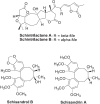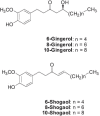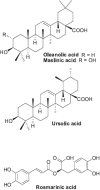Recent Progress of Research on Herbal Products Used in Traditional Chinese Medicine: the Herbs belonging to The Divine Husbandman's Herbal Foundation Canon ( Shén Nóng Běn Cǎo Jīng)
- PMID: 24716110
- PMCID: PMC3943012
- DOI: 10.1016/s2225-4110(16)30066-9
Recent Progress of Research on Herbal Products Used in Traditional Chinese Medicine: the Herbs belonging to The Divine Husbandman's Herbal Foundation Canon ( Shén Nóng Běn Cǎo Jīng)
Abstract
This article will review selected herbal products from Chinese Materia Medica that are used in Traditional Chinese Medicine. The herbs come from the upper, middle, and lower class medicines as listed in The Divine Husbandman's Herbal Foundation Canon ( Shén Nóng Běn Cǎo Jīng). The review will focus on the active constituents of the herbs and their bioactivities, with emphasis on the most recent progress in research for the period of 2003 to 2011.
Keywords: Chinese Materia Medica (CMM) (中藥 zhōng yào); Herbal products; Shén Nóng Běn Cǎo Jīng (神農本草經 The Divine Husbandman's Herbal Foundation Canon by Shen Nong); Traditional Chinese Medicine (TCM).
Figures



















Similar articles
-
[The medical transformation by 'Fang-Shu' in the Qin and Han Dynasties].Zhonghua Yi Shi Za Zhi. 2024 Nov 28;54(6):323-326. doi: 10.3760/cma.j.cn112155-20240612-00081. Zhonghua Yi Shi Za Zhi. 2024. PMID: 39929690 Chinese.
-
[Textual research on Costus root (Aucklandia lappa Decne) in the Sheng nong ben cao jing (Shennong's Classic of Materia Medica)].Zhonghua Yi Shi Za Zhi. 2014 May;44(3):135-7. Zhonghua Yi Shi Za Zhi. 2014. PMID: 25208833 Chinese.
-
[Geographical views in traditional Chinese medicine].Zhongguo Zhong Yao Za Zhi. 2022 Dec;47(23):6287-6296. doi: 10.19540/j.cnki.cjcmm.20220624.101. Zhongguo Zhong Yao Za Zhi. 2022. PMID: 36604873 Chinese.
-
Ganoderma (Lingzhi) in Traditional Chinese Medicine and Chinese Culture.Adv Exp Med Biol. 2019;1181:1-13. doi: 10.1007/978-981-13-9867-4_1. Adv Exp Med Biol. 2019. PMID: 31677138 Review.
-
Traditional Chinese Medicine Induced Liver Injury.J Clin Transl Hepatol. 2014 Jun;2(2):80-94. doi: 10.14218/JCTH.2014.00003. Epub 2014 Jun 15. J Clin Transl Hepatol. 2014. PMID: 26357619 Free PMC article. Review.
Cited by
-
Diol-ginsenosides from Korean Red Ginseng delay the development of type 1 diabetes in diabetes-prone biobreeding rats.J Ginseng Res. 2020 Jul;44(4):619-626. doi: 10.1016/j.jgr.2019.06.001. Epub 2019 Jun 12. J Ginseng Res. 2020. PMID: 32617042 Free PMC article.
-
Kaempferol 3-O-Rutinoside, a Flavone Derived from Tetrastigma hemsleyanum Diels et Gilg, Reduces Body Temperature through Accelerating the Elimination of IL-6 and TNF-α in a Mouse Fever Model.Molecules. 2024 Apr 5;29(7):1641. doi: 10.3390/molecules29071641. Molecules. 2024. PMID: 38611918 Free PMC article.
-
Anti-Inflammatory Effect of Ebractenoid F, a Major Active Compound of Euphorbia ebracteolata Hayata, through Inhibition of Nuclear Factor-κB Activation.Plants (Basel). 2023 Aug 1;12(15):2845. doi: 10.3390/plants12152845. Plants (Basel). 2023. PMID: 37570999 Free PMC article.
-
Molecular Action Mechanism of Coixol from Soft-Shelled Adlay on Tyrosinase: The Future of Cosmetics.Molecules. 2022 Jul 20;27(14):4626. doi: 10.3390/molecules27144626. Molecules. 2022. PMID: 35889498 Free PMC article.
-
Comprehensive Identification of Guan-Xin-Shu-Tong Capsule via a Mass Defect and Fragment Filtering Approach by High Resolution Mass Spectrometry: In Vitro and In Vivo Study.Molecules. 2017 Jun 16;22(6):1007. doi: 10.3390/molecules22061007. Molecules. 2017. PMID: 28621737 Free PMC article.
References
-
- Abd-Elazem I.S., Chen H.S., Bates R.B., Huang RCC. Isolation of two highly potent and non-toxic inhibitors of human immunodeficiency virus type 1 (HIV-1) integrase from Salvia miltiorrhiza. Antiviral Research. 2002;55:91–106. - PubMed
-
- Ai C., Li L. Stereostructure of salvianolic acid B and isolation of salvianolic acid C from Salvia miltiorrhiza. Journal of Natural Products. 1988;51:145–149.
-
- Ali B.H., Blunden B., Tanira M.O., Nemmar A. Some phytochemical, pharmacological and toxicological properties of ginger (Zingiber officinale Roscoe): a review of recent research. Food and Chemical Toxicology. 2008;46:409–420. - PubMed
-
- Amagase H., Farnsworth N.R. A review of botanical characteristics, phytochemistry, clinical relevance in efficacy and safety of Lycium barbarum fruit (Goji) Food Research International. 2011;44:1702–1717.
-
- Amiya Tin, Bando H. In: The Alkaloids. Brossi A., editor. Vol. 34. San Diego: Academic Press; 1988. pp. 95–179.
Publication types
LinkOut - more resources
Full Text Sources
